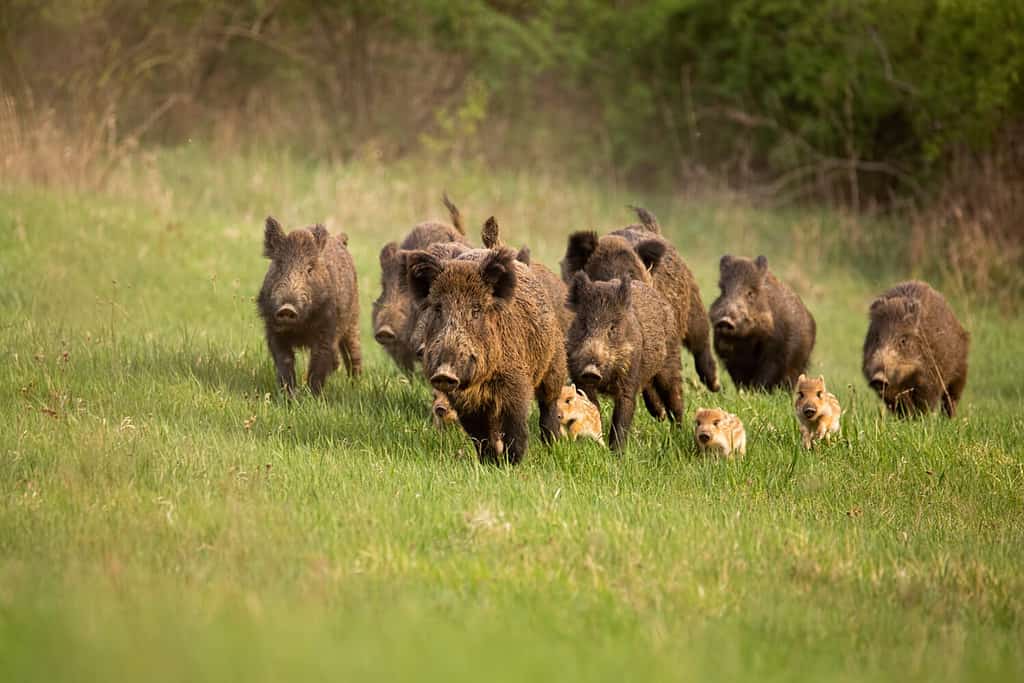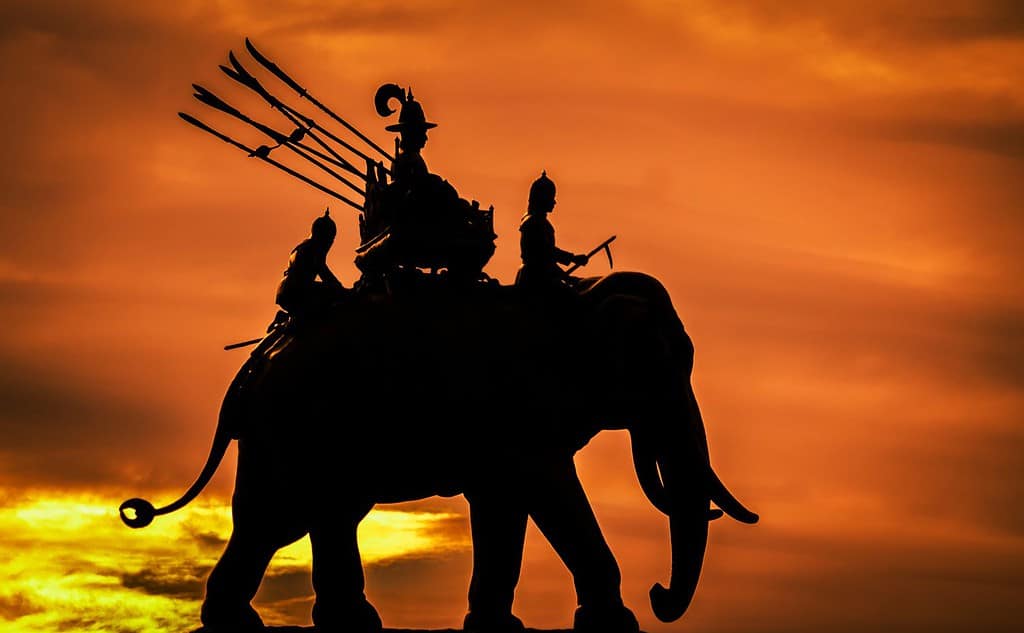In the ancient world, perhaps no animal was as intimidating on the battlefield as a fully armored battle elephant. These massive beasts were used by the empires of the Mediterranean and South Asia to charge enemy lines, break up battle formations, and induce panicked terror in enemy soldiers and their mounts. And you might be surprised to know that war elephants played a military support role as late as World War II! Read on to find out more.
Where Did Elephants Live?

People first tamed elephants to use them in agricultural tasks, like clearing trees to create new farmland.
©MossStudio/Shutterstock.com
Asian elephants were the first elephant species to be tamed and they were originally used for agricultural tasks. Their immense strength made them valuable helpers in clearing land of trees and moving heavy loads. As today, ancient elephants lived in Africa and South Asia. However, their range once extended through Mesopotamia and into central China. They went extinct in both of these places as the human population grew and farmland replaced forests.
How Were Elephants Trained?

A person in India who trains or rides elephants is called a mahout.
©Sutipond Somnam/Shutterstock.com
In India, the process of training an elephant has changed little since ancient times. They captured elephants in the wild because they are difficult to breed and maintain for years in captivity. Male 60-year-old elephants were considered the ideal age and gender for military service, as female elephants would retreat from aggressive male elephants in battle. Mahouts, or elephant trainers, trained elephants using chains and a hook called an “elephant goad.” The animal grew accustomed to being led, raising its leg to provide a stepstool for riders, and running and dodging obstacles on command. Elephants are highly intelligent and can be trained to perform complex maneuvers, charging at and trampling anything.
What Military Roles Did War Elephants Serve?
Psychological Warfare
South Asian kingdoms maintained thousands of elephants as an indispensable part of their military forces. Battle elephants were trained to walk in formation in regiments hundreds or thousands of elephants strong. This would have been a terrifying sight to the enemy, and a morale booster to one’s own soldiers. The fearsome 6,000 war elephants of the Nanda Army led to mutiny among Alexander the Great’s battle-weary troops. Horrifically, elephants were also used to crush captured enemies, spreading terror among anyone thinking of taking on this elephant army in the future.
Surveillance and Combat

When both armies had battle elephants, they fought viciously with one another.
©natrada kittirangsee/Shutterstock.com
In battle, elephants provided a commanding platform for leaders to survey the battlefield and shout out orders. They could charge through enemy lines, trampling down defenses, soldiers, horses, and chariots, often causing a panicked retreat. And get this: elephants could also use their trunk to swing a heavy iron ball attached to a chain! Reportedly, they could be quite skillful and accurate at hitting their desired target.
When both sides had elephants, the animals were forced to do battle with one another, with humans on their backs hurling projectiles and wielding spears and swords to affect the outcome. After the introduction of cannons, some elephants were trained to tolerate the noise of a small cannon firing from a platform on their back, making them quite literally tanks.
Logistics and Engineering
War elephants could pull heavy loads of military equipment as well as transport troops. Moving at about 19 mph (30 km/h), they could transport troops quickly and use their strength to remove obstacles from the path of the army. They could take down trees and move them for use in building defensive fortifications or offensive battering rams and siegeworks. And they could destroy similar projects on the enemy side.
Defending Against War Elephants

Hannibal’s attempt to bring war elephants over the Alps was ill-fated due to rough terrain and cold.
©Melinda Nagy/Shutterstock.com
Picking Battles, and Battlefields
The best defense against war elephants was to avoid conflict with them altogether. Kingdoms without adequate elephants of their own would try not to antagonize powerful armed neighbors. If war did break out, one defense was to concentrate one’s defensive forces into densely forested, hilly, or rocky terrain. This denied the enemy elephantry the wide, open, flat spaces it needed to operate in large, coordinated formations and made it easier to isolate and pick off elephants one at a time. Historically, Hannibal’s attempt to invade Italy with elephants brought through the Alps was disastrous, as many of the valuable creatures perished by losing their footing in the rugged mountains and dying from cold weather.
Animal Abuse

Pigs, like these wild boars, could panic elephants with their piercing squeals.
©WildMedia/Shutterstock.com
Other animals were also used to try to disrupt and panic elephant attacks as well. The methods used were disturbingly cruel. The most effective defenders were one’s own trained military elephants, which could fight with their tusks and rear up to strike with their heavy front feet. Ancients thought elephants feared squealing pigs, so in some cases, armies set pigs on fire and stampeded them into elephant formations to induce panic. Tamerlane, whose medieval empire lay to the north and west of India, successfully used the same strategy with flaming camels.
This was a risky strategy because terrified elephants could stampede indiscriminately, inflicting losses on both sides of the battle line. As the Romans gained experience in fighting elephants, they found it more reliable to use massed spear defenses or coordinated javelin attacks focused systematically on one animal at a time to overwhelm it with wounds. Striking at the animals’ tusks with swords also was an effective but cruel way to induce pain and fear.
What Caused the Decline of Battle Elephants?

Battle elephants declined as a result of the invention of advanced weaponry.
©Chokniti-Studio/Shutterstock.com
Truth be told, military elephants have never really gone away. They still feature in parades and processions reminiscent of their historical role and fill people with pride. However, the development of gunpowder-based weapons like firearms and cannons made them ineffective in large-scale battles. Even so, they continued to be a significant part of the militaries of some countries through the Medieval era. Smaller countries like Myanmar, Vietnam, and Thailand were still using battle elephants in the 19th century in small numbers through rough terrain.

Asian countries used battle elephants until they gained widespread access to modern weaponry.
©Stefano Ember/Shutterstock.com
Believe it or not, as late as World War II, the British used elephants for military logistics in Burma (Myanmar). Working in areas where motorized vehicles had trouble operating, elephants performed traditional roles of clearing paths and lifting heavy loads. They built bridges, dragged heavy military equipment including airplanes on runways, and transported shipbuilding materials.
A Mixed Legacy

War elephants were intimidating, but unpredictable.
©Turian/Shutterstock.com
Military historians are divided on the military usefulness of war elephants, especially given their propensity to bolt unpredictably when frightened. Fortunately, warfare has largely become a thing of the past for these magnificent, intelligent, and long-suffering creatures. We can hope for the day when we can say the same about human beings.
The photo featured at the top of this post is © venusvi/Shutterstock.com
Thank you for reading! Have some feedback for us? Contact the AZ Animals editorial team.







